winter tyres SKODA ROOMSTER 2006 1.G Owner's Manual
[x] Cancel search | Manufacturer: SKODA, Model Year: 2006, Model line: ROOMSTER, Model: SKODA ROOMSTER 2006 1.GPages: 274, PDF Size: 48.64 MB
Page 181 of 274
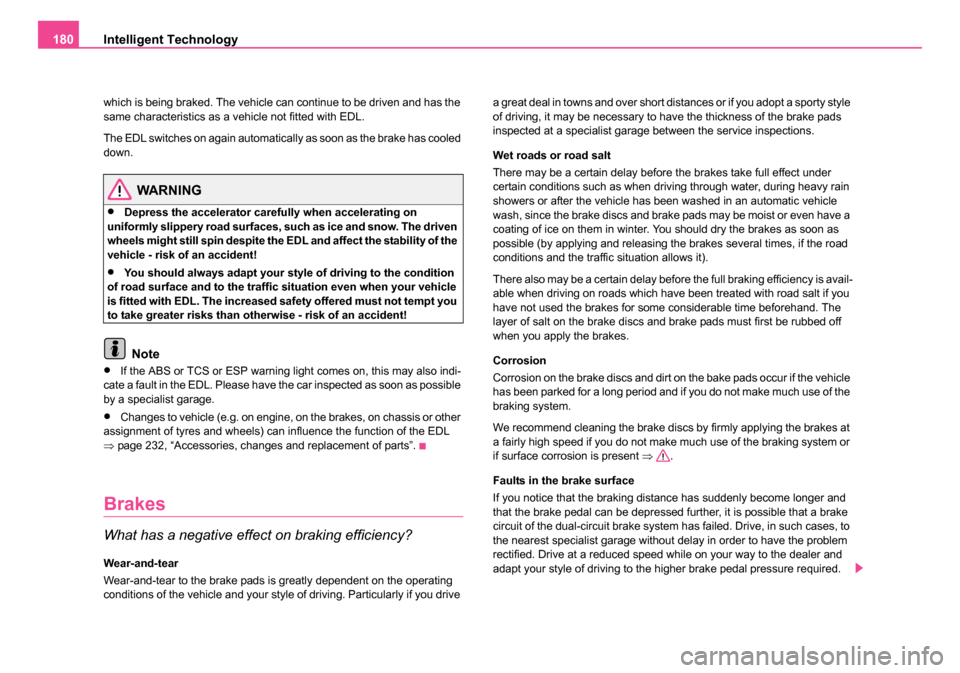
Intelligent Technology
180
which is being braked. The vehicle can continue to be driven and has the
same characteristics as a vehicle not fitted with EDL.
The EDL switches on again automatically as soon as the brake has cooled
down.
WARNING
•Depress the accelerator carefully when accelerating on
uniformly slippery road surfaces, such as ice and snow. The driven
wheels might still spin despite the EDL and affect the stability of the
vehicle - risk of an accident!
•You should always adapt your style of driving to the condition
of road surface and to the traffic situation even when your vehicle
is fitted with EDL. The increased safety offered must not tempt you
to take greater risks than otherwise - risk of an accident!
Note
•If the ABS or TCS or ESP warning li ght comes on, this may also indi-
cate a fault in the EDL. Please have the car inspected as soon as possible
by a specialist garage.
•Changes to vehicle (e.g. on engine, on the brakes, on chassis or other
assignment of tyres and wheels) can influence the function of the EDL
⇒ page 232, “Accessories, changes and replacement of parts”.
Brakes
What has a negative effect on braking efficiency?
Wear-and-tear
Wear-and-tear to the brake pads is greatly dependent on the operating
conditions of the vehicle and your style of driving. Particularly if you drive a great deal in towns and over short distances or if you adopt a sporty style
of driving, it may be necessary to have the thickness of the brake pads
inspected at a specialist garage between the service inspections.
Wet roads or road salt
There may be a certain delay before the brakes take full effect under
certain conditions such as when driving through water, during heavy rain
showers or after the vehicle has been washed in an automatic vehicle
wash, since the brake discs and brake pads may be moist or even have a
coating of ice on them in winter. You should dry the brakes as soon as
possible (by applying and releasing the brakes several times, if the road
conditions and the traffic situation allows it).
There also may be a certain delay before the full braking efficiency is avail-
able when driving on roads which have been treated with road salt if you
have not used the brakes for some considerable time beforehand. The
layer of salt on the brake discs and brake pads must first be rubbed off
when you apply the brakes.
Corrosion
Corrosion on the brake discs and dirt on the bake pads occur if the vehicle
has been parked for a long period and if you do not make much use of the
braking system.
We recommend cleaning the brake discs by firmly applying the brakes at
a fairly high speed if you do not make much use of the braking system or
if surface corrosion is present
⇒.
Faults in the brake surface
If you notice that the braking distance has suddenly become longer and
that the brake pedal can be depressed further, it is possible that a brake
circuit of the dual-circuit brake system has failed. Drive, in such cases, to
the nearest specialist garage without delay in order to have the problem
rectified. Drive at a reduced speed while on your way to the dealer and
adapt your style of driving to the higher brake pedal pressure required.
NKO 20 A05.book Page 180 Wednesday, June 21, 2006 1:42 PM
Page 185 of 274
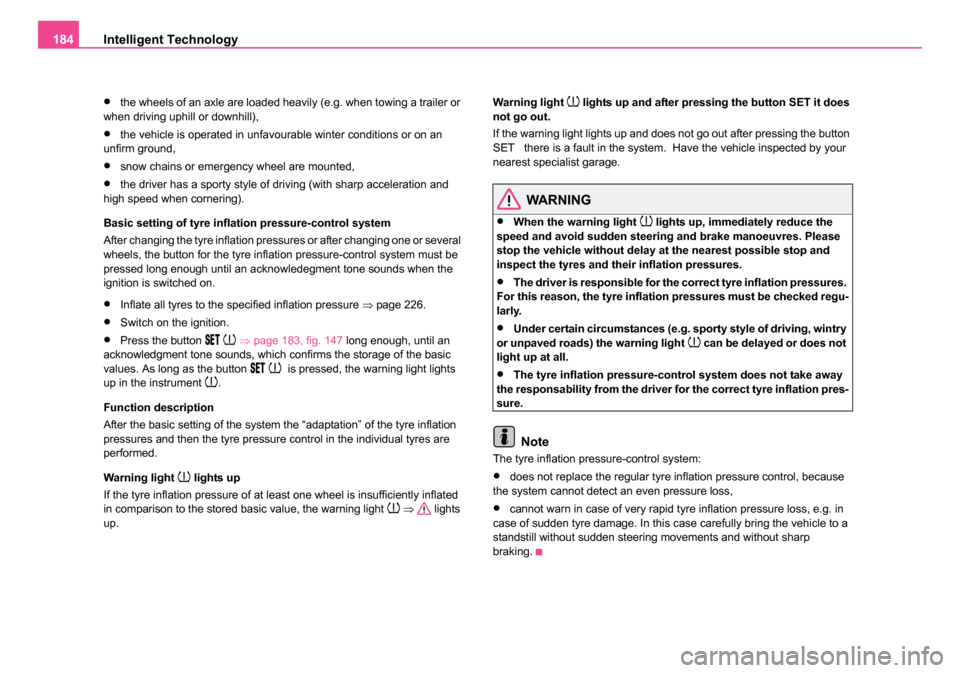
Intelligent Technology
184
•the wheels of an axle are loaded heavily (e.g. when towing a trailer or
when driving uphill or downhill),
•the vehicle is operated in unfavourable winter conditions or on an
unfirm ground,
•snow chains or emergency wheel are mounted,
•the driver has a sporty style of driving (with sharp acceleration and
high speed when cornering).
Basic setting of tyre inflation pressure-control system
After changing the tyre inflation pressures or after changing one or several
wheels, the button for the tyre inflation pressure-control system must be
pressed long enough until an acknowledegment tone sounds when the
ignition is switched on.
•Inflate all tyres to the specified inflation pressure ⇒page 226.
•Switch on the ignition.
•Press the button ⇒ page 183, fig. 147 long enough, until an
acknowledgment tone sounds, which confirms the storage of the basic
values. As long as the button
is pressed, the warning light lights
up in the instrument .
Function description
After the basic setting of the system the “adaptation” of the tyre inflation
pressures and then the tyre pressure control in the individual tyres are
performed.
Warning light
lights up
If the tyre inflation pressure of at least one wheel is insufficiently inflated
in comparison to the stored basic value, the warning light
⇒ lights
up. Warning light
lights up and after pressing the button SET it does
not go out.
If the warning light lights up and does not go out after pressing the button
SET there is a fault in the system. Have the vehicle inspected by your
nearest specialist garage.
WARNING
•When the warning light lights up, immediately reduce the
speed and avoid sudden steering and brake manoeuvres. Please
stop the vehicle without delay at the nearest possible stop and
inspect the tyres and their inflation pressures.
•The driver is responsible for the correct tyre inflation pressures.
For this reason, the tyre inflation pressures must be checked regu-
larly.
•Under certain circumstances (e.g. sporty style of driving, wintry
or unpaved roads) the warning light can be delayed or does not
light up at all.
•The tyre inflation pressure-control system does not take away
the responsability from the driver for the correct tyre inflation pres-
sure.
Note
The tyre inflation pressure-control system:
•does not replace the regular tyre inflation pressure control, because
the system cannot detect an even pressure loss,
•cannot warn in case of very rapid tyre inflation pressure loss, e.g. in
case of sudden tyre damage. In this case carefully bring the vehicle to a
standstill without sudden steering movements and without sharp
braking.
NKO 20 A05.book Page 184 Wednesday, June 21, 2006 1:42 PM
Page 188 of 274
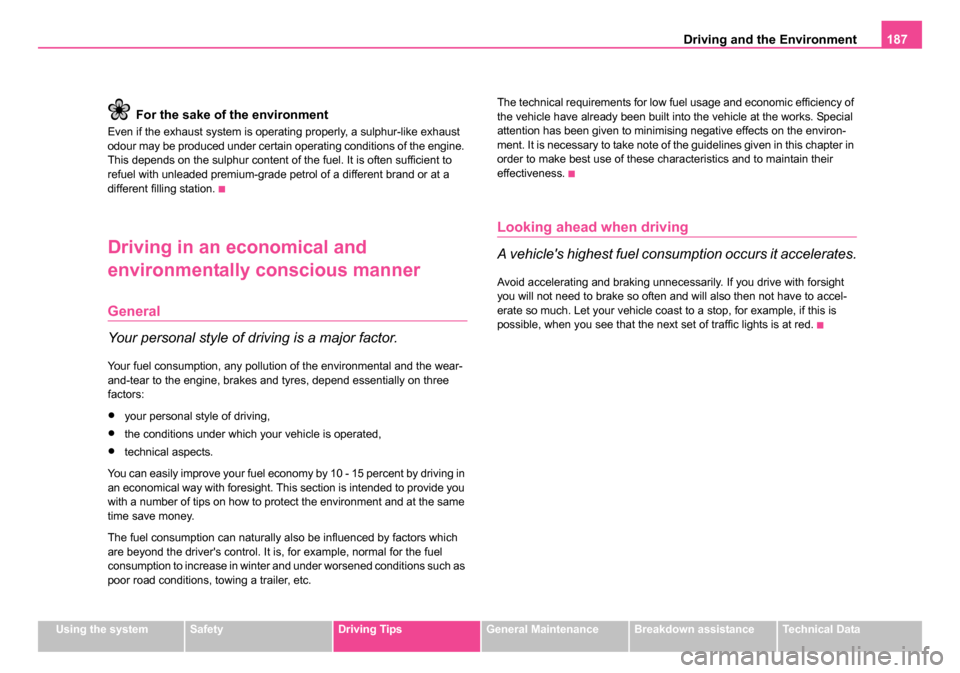
Driving and the Environment187
Using the systemSafetyDriving TipsGeneral MaintenanceBreakdown assistanceTechnical Data
For the sake of the environment
Even if the exhaust system is operating properly, a sulphur-like exhaust
odour may be produced under certain operating conditions of the engine.
This depends on the sulphur content of the fuel. It is often sufficient to
refuel with unleaded premium-grade petrol of a different brand or at a
different filling station.
Driving in an economical and
environmentally conscious manner
General
Your personal style of driving is a major factor.
Your fuel consumption, any pollution of the environmental and the wear-
and-tear to the engine, brakes and tyres, depend essentially on three
factors:
•your personal style of driving,
•the conditions under which your vehicle is operated,
•technical aspects.
You can easily improve your fuel economy by 10 - 15 percent by driving in
an economical way with foresight. This section is intended to provide you
with a number of tips on how to protect the environment and at the same
time save money.
The fuel consumption can naturally also be influenced by factors which
are beyond the driver's control. It is, for example, normal for the fuel
consumption to increase in winter and under worsened conditions such as
poor road conditions, towing a trailer, etc. The technical requirements for low fuel usage and economic efficiency of
the vehicle have already been built into the vehicle at the works. Special
attention has been given to minimising negative effects on the environ-
ment. It is necessary to take note of the guidelines given in this chapter in
order to make best use of these characteristics and to maintain their
effectiveness.
Looking ahead when driving
A vehicle's highest fuel consumption occurs it accelerates.
Avoid accelerating and braking unnecessarily. If you drive with forsight
you will not need to brake so often and will also then not have to accel-
erate so much. Let your vehicle coast to a stop, for example, if this is
possible, when you see that the next set of traffic lights is at red.
NKO 20 A05.book Page 187 Wednesday, June 21, 2006 1:42 PM
Page 191 of 274
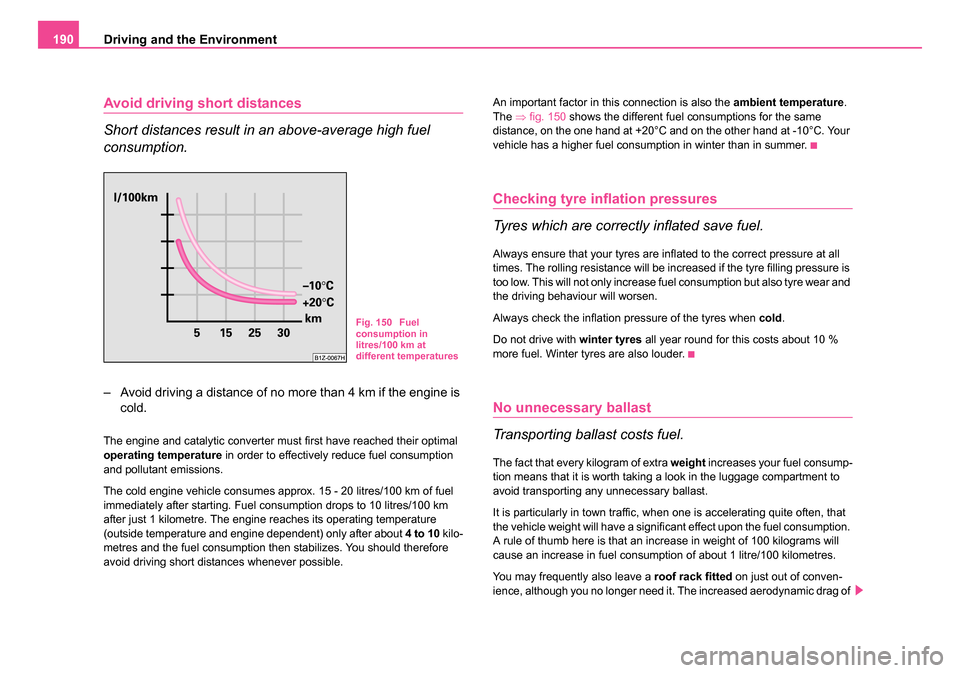
Driving and the Environment
190
Avoid driving short distances
Short distances result in an above-average high fuel
consumption.
– Avoid driving a distance of no more than 4 km if the engine is
cold.
The engine and catalytic converter must first have reached their optimal
operating temperature in order to effectively reduce fuel consumption
and pollutant emissions.
The cold engine vehicle consumes approx. 15 - 20 litres/100 km of fuel
immediately after starting. Fuel consumption drops to 10 litres/100 km
after just 1 kilometre. The engine reaches its operating temperature
(outside temperature and engine dependent) only after about 4 to 10 kilo-
metres and the fuel consumption then stabilizes. You should therefore
avoid driving short distances whenever possible. An important factor in this connection is also the
ambient temperature.
The ⇒fig. 150 shows the different fuel consumptions for the same
distance, on the one hand at +20°C and on the other hand at -10°C. Your
vehicle has a higher fuel consumption in winter than in summer.
Checking tyre inflation pressures
Tyres which are correctly inflated save fuel.
Always ensure that your tyres are inflated to the correct pressure at all
times. The rolling resistance will be increased if the tyre filling pressure is
too low. This will not only increase fuel consumption but also tyre wear and
the driving behaviour will worsen.
Always check the inflation pressure of the tyres when cold.
Do not drive with winter tyres all year round for this costs about 10 %
more fuel. Winter tyres are also louder.
No unnecessary ballast
Transporting ballast costs fuel.
The fact that every kilogram of extra weight increases your fuel consump-
tion means that it is worth taking a look in the luggage compartment to
avoid transporting any unnecessary ballast.
It is particularly in town traffic, when one is accelerating quite often, that
the vehicle weight will have a significant effect upon the fuel consumption.
A rule of thumb here is that an increase in weight of 100 kilograms will
cause an increase in fuel consumption of about 1 litre/100 kilometres.
You may frequently also leave a roof rack fitted on just out of conven-
ience, although you no longer need it. The increased aerodynamic drag of
Fig. 150 Fuel
consumption in
litres/100 km at
different temperatures
NKO 20 A05.book Page 190 Wednesday, June 21, 2006 1:42 PM
Page 227 of 274
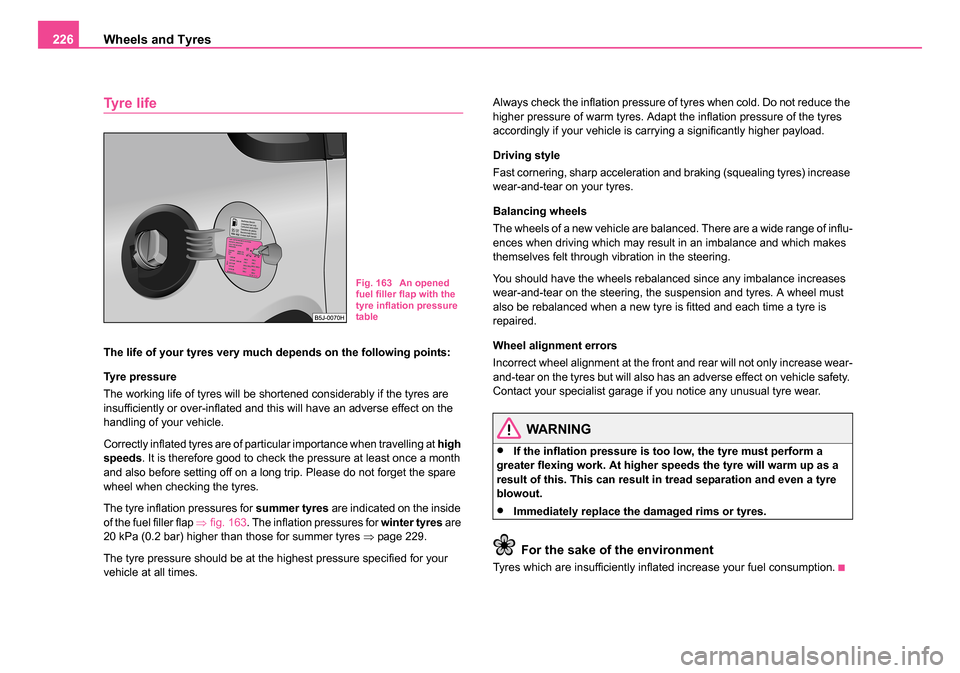
Wheels and Tyres
226
Tyre life
The life of your tyres very much depends on the following points:
Tyre pressure
The working life of tyres will be shortened considerably if the tyres are
insufficiently or over-inflated and this will have an adverse effect on the
handling of your vehicle.
Correctly inflated tyres are of particular importance when travelling at high
speeds . It is therefore good to check the pressure at least once a month
and also before setting off on a long trip. Please do not forget the spare
wheel when checking the tyres.
The tyre inflation pressures for summer tyres are indicated on the inside
of the fuel filler flap ⇒fig. 163 . The inflation pressures for winter tyres are
20 kPa (0.2 bar) higher than those for summer tyres ⇒page 229.
The tyre pressure should be at the highest pressure specified for your
vehicle at all times. Always check the inflation pressure of tyres when cold. Do not reduce the
higher pressure of warm tyres. Adapt the inflation pressure of the tyres
accordingly if your vehicle is carrying a significantly higher payload.
Driving style
Fast cornering, sharp acceleration and braking (squealing tyres) increase
wear-and-tear on your tyres.
Balancing wheels
The wheels of a new vehicle are balanced. There are a wide range of influ-
ences when driving which may result in an imbalance and which makes
themselves felt through vibration in the steering.
You should have the wheels rebalanced since any imbalance increases
wear-and-tear on the steering, the suspension and tyres. A wheel must
also be rebalanced when a new tyre is fitted and each time a tyre is
repaired.
Wheel alignment errors
Incorrect wheel alignment at the front and rear will not only increase wear-
and-tear on the tyres but will also has an adverse effect on vehicle safety.
Contact your specialist garage if you notice any unusual tyre wear.
WARNING
•If the inflation pressu
re is too low, the tyre must perform a
greater flexing work. At higher sp eeds the tyre will warm up as a
result of this. This can result in tread separation and even a tyre
blowout.
•Immediately replace the damaged rims or tyres.
For the sake of the environment
Tyres which are insufficiently inflated increase your fuel consumption.
Fig. 163 An opened
fuel filler flap with the
tyre inflation pressure
table
NKO 20 A05.book Page 226 Wednesday, June 21, 2006 1:42 PM
Page 229 of 274
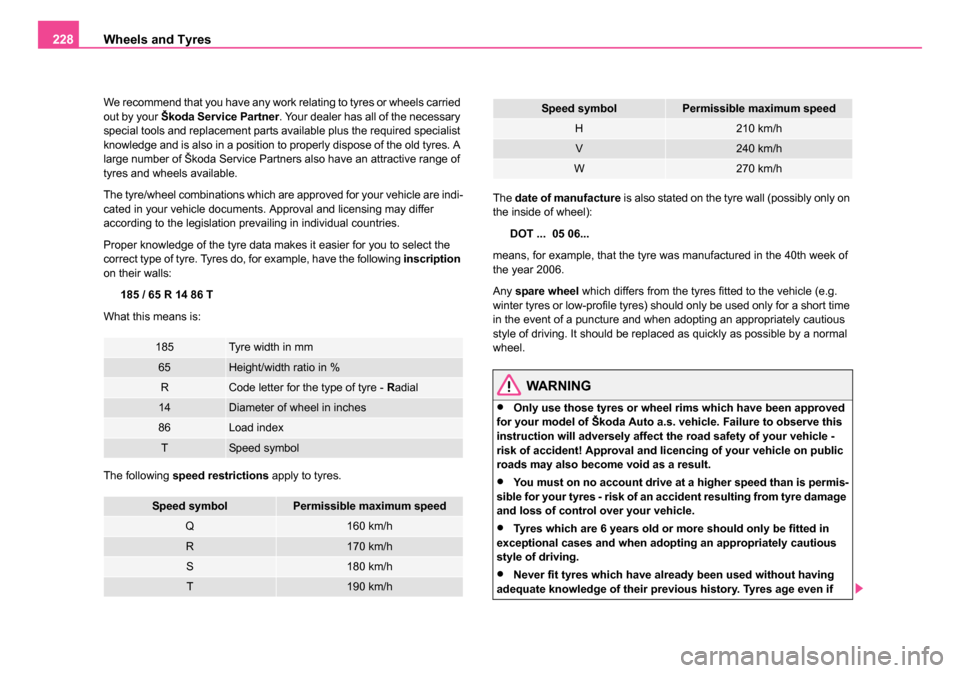
Wheels and Tyres
228
We recommend that you have any work relating to tyres or wheels carried
out by your Škoda Service Partner . Your dealer has all of the necessary
special tools and replacement parts available plus the required specialist
knowledge and is also in a position to properly dispose of the old tyres. A
large number of Škoda Service Partners also have an attractive range of
tyres and wheels available.
The tyre/wheel combinations which are approved for your vehicle are indi-
cated in your vehicle documents. Approval and licensing may differ
according to the legislation prevailing in individual countries.
Proper knowledge of the tyre data makes it easier for you to select the
correct type of tyre. Tyres do, for example, have the following inscription
on their walls:
185 / 65 R 14 86 T
What this means is:
The following speed restrictions apply to tyres. The
date of manufacture is also stated on the tyre wall (possibly only on
the inside of wheel):
DOT ... 05 06...
means, for example, that the tyre was manufactured in the 40th week of
the year 2006.
Any spare wheel which differs from the tyres fitted to the vehicle (e.g.
winter tyres or low-profile tyres) should only be used only for a short time
in the event of a puncture and when adopting an appropriately cautious
style of driving. It should be replaced as quickly as possible by a normal
wheel.
WARNING
•Only use those tyres or wheel ri ms which have been approved
for your model of Škoda Auto a.s. vehicle. Failure to observe this
instruction will adversely affect the road safety of your vehicle -
risk of accident! Approval and licencing of your vehicle on public
roads may also become void as a result.
•You must on no account drive at a higher speed than is permis-
sible for your tyres - risk of an accident resulting from tyre damage
and loss of control over your vehicle.
•Tyres which are 6 years old or more should only be fitted in
exceptional cases and when adopting an appropriately cautious
style of driving.
•Never fit tyres which have already been used without having
adequate knowledge of their previous history. Tyres age even if
185Tyr e wi dth i n mm
65Height/width ratio in %
RCode letter for the type of tyre - Radial
14Diameter of wheel in inches
86Load index
TSpeed symbol
Speed symbolPermissible maximum speed
Q160 km/h
R170 km/h
S180 km/h
T190 km/h
H210 km/h
V240 km/h
W270 km/h
Speed symbolPermissible maximum speed
NKO 20 A05.book Page 228 Wednesday, June 21, 2006 1:42 PM
Page 230 of 274
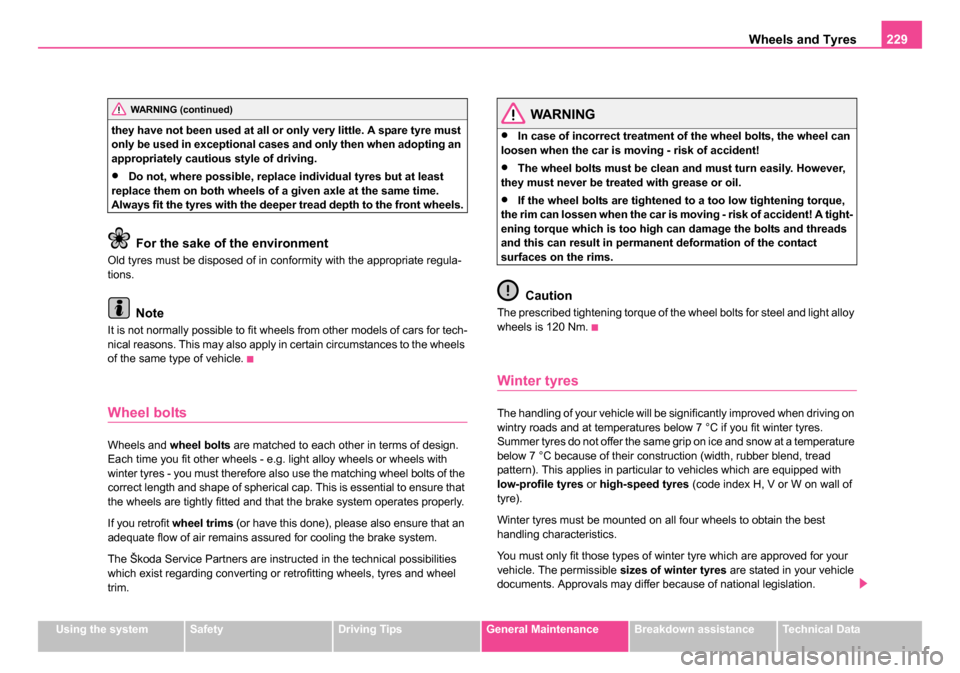
Wheels and Tyres229
Using the systemSafetyDriving TipsGeneral MaintenanceBreakdown assistanceTechnical Data
they have not been used at all or only very little. A spare tyre must
only be used in exceptional cases and only then when adopting an
appropriately cautious style of driving.
•Do not, where possible, replace individual tyres but at least
replace them on both wheels of a given axle at the same time.
Always fit the tyres with the deeper tread depth to the front wheels.
For the sake of the environment
Old tyres must be disposed of in conformity with the appropriate regula-
tions.
Note
It is not normally possible to fit wheels from other models of cars for tech-
nical reasons. This may also apply in certain circumstances to the wheels
of the same type of vehicle.
Wheel bolts
Wheels and wheel bolts are matched to each other in terms of design.
Each time you fit other wheels - e.g. light alloy wheels or wheels with
winter tyres - you must therefore also use the matching wheel bolts of the
correct length and shape of spherical cap. This is essential to ensure that
the wheels are tightly fitted and that the brake system operates properly.
If you retrofit wheel trims (or have this done), please also ensure that an
adequate flow of air remains assured for cooling the brake system.
The Škoda Service Partners are instructed in the technical possibilities
which exist regarding converting or retrofitting wheels, tyres and wheel
trim.
WARNING
•In case of incorrect treatment of the wheel bolts, the wheel can
loosen when the car is moving - risk of accident!
•The wheel bolts must be clean and must turn easily. However,
they must never be treated with grease or oil.
•If the wheel bolts are tightened to a too low tightening torque,
the rim can lossen when the car is moving - risk of accident! A tight-
ening torque which is too high can damage the bolts and threads
and this can result in perman ent deformation of the contact
surfaces on the rims.
Caution
The prescribed tightening torque of the wheel bolts for steel and light alloy
wheels is 120 Nm.
Winter tyres
The handling of your vehicle will be significantly improved when driving on
wintry roads and at temperatures below 7 °C if you fit winter tyres.
Summer tyres do not offer the same grip on ice and snow at a temperature
below 7 °C because of their construction (width, rubber blend, tread
pattern). This applies in particular to vehicles which are equipped with
low-profile tyres or high-speed tyres (code index H, V or W on wall of
tyre).
Winter tyres must be mounted on all four wheels to obtain the best
handling characteristics.
You must only fit those types of winter tyre which are approved for your
vehicle. The permissible sizes of winter tyres are stated in your vehicle
documents. Approvals may differ because of national legislation.
WARNING (continued)
NKO 20 A05.book Page 229 Wednesday, June 21, 2006 1:42 PM
Page 231 of 274
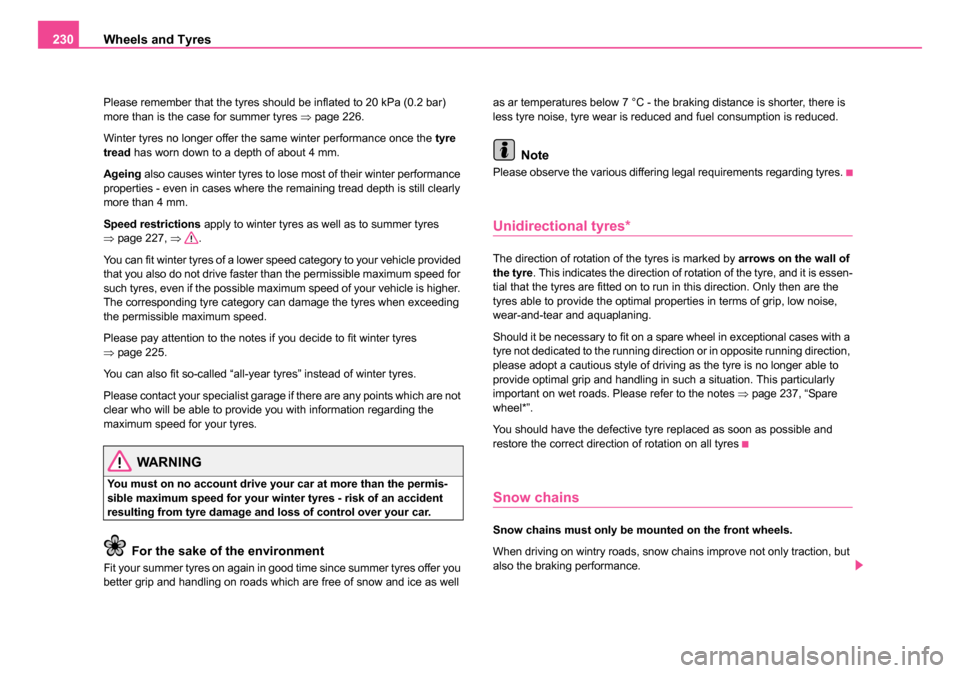
Wheels and Tyres
230
Please remember that the tyres should be inflated to 20 kPa (0.2 bar)
more than is the case for summer tyres ⇒page 226.
Winter tyres no longer offer the same winter performance once the tyre
tread has worn down to a depth of about 4 mm.
Ageing also causes winter tyres to lose most of their winter performance
properties - even in cases where the remaining tread depth is still clearly
more than 4 mm.
Speed restrictions apply to winter tyres as well as to summer tyres
⇒ page 227, ⇒.
You can fit winter tyres of a lower speed category to your vehicle provided
that you also do not drive faster than the permissible maximum speed for
such tyres, even if the possible maximum speed of your vehicle is higher.
The corresponding tyre category can damage the tyres when exceeding
the permissible maximum speed.
Please pay attention to the notes if you decide to fit winter tyres
⇒ page 225.
You can also fit so-called “all-year tyres” instead of winter tyres.
Please contact your specialist garage if there are any points which are not
clear who will be able to provide you with information regarding the
maximum speed for your tyres.
WARNING
You must on no account drive your car at more than the permis-
sible maximum speed for your winter tyres - risk of an accident
resulting from tyre damage and loss of control over your car.
For the sake of the environment
Fit your summer tyres on again in good time since summer tyres offer you
better grip and handling on roads which are free of snow and ice as well as ar temperatures below 7 °C - the braking distance is shorter, there is
less tyre noise, tyre wear is reduced and fuel consumption is reduced.
Note
Please observe the various differing legal requirements regarding tyres.
Unidirectional tyres*
The direction of rotation of the tyres is marked by
arrows on the wall of
the tyre . This indicates the direction of rotation of the tyre, and it is essen-
tial that the tyres are fitted on to run in this direction. Only then are the
tyres able to provide the optimal properties in terms of grip, low noise,
wear-and-tear and aquaplaning.
Should it be necessary to fit on a spare wheel in exceptional cases with a
tyre not dedicated to the running direction or in opposite running direction,
please adopt a cautious style of driving as the tyre is no longer able to
provide optimal grip and handling in such a situation. This particularly
important on wet roads. Please refer to the notes ⇒page 237, “Spare
wheel*”.
You should have the defective tyre replaced as soon as possible and
restore the correct direction of rotation on all tyres
Snow chains
Snow chains must only be mounted on the front wheels.
When driving on wintry roads, snow chains improve not only traction, but
also the braking performance.
NKO 20 A05.book Page 230 Wednesday, June 21, 2006 1:42 PM
Page 269 of 274
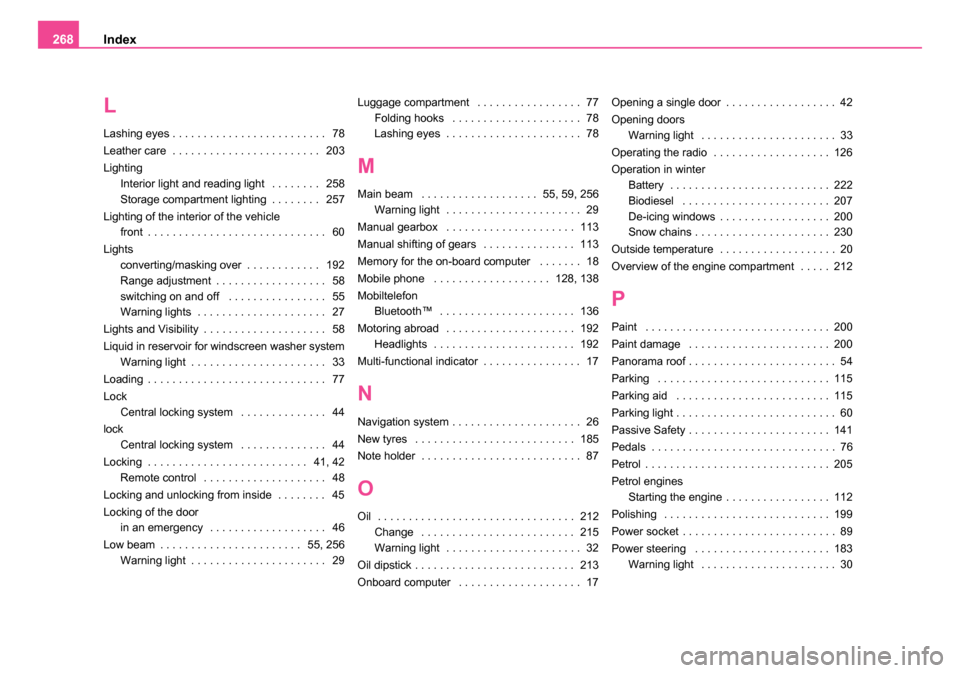
Index
268
L
Lashing eyes . . . . . . . . . . . . . . . . . . . . . . . . . 78
Leather care . . . . . . . . . . . . . . . . . . . . . . . . 203
Lighting
Interior light and reading light . . . . . . . . 258
Storage compartment lighting . . . . . . . . 257
Lighting of the interior of the vehicle front . . . . . . . . . . . . . . . . . . . . . . . . . . . . . 60
Lights converting/masking over . . . . . . . . . . . . 192
Range adjustment . . . . . . . . . . . . . . . . . . 58
switching on and off . . . . . . . . . . . . . . . . 55
Warning lights . . . . . . . . . . . . . . . . . . . . . 27
Lights and Visibility . . . . . . . . . . . . . . . . . . . . 58
Liquid in reservoir for windscreen washer system Warning light . . . . . . . . . . . . . . . . . . . . . . 33
Loading . . . . . . . . . . . . . . . . . . . . . . . . . . . . . 77
Lock Central locking system . . . . . . . . . . . . . . 44
lock Central locking system . . . . . . . . . . . . . . 44
Locking . . . . . . . . . . . . . . . . . . . . . . . . . . 41, 42 Remote control . . . . . . . . . . . . . . . . . . . . 48
Locking and unlocking from inside . . . . . . . . 45
Locking of the door in an emergency . . . . . . . . . . . . . . . . . . . 46
Low beam . . . . . . . . . . . . . . . . . . . . . . . 55, 256 Warning light . . . . . . . . . . . . . . . . . . . . . . 29 Luggage compartment . . . . . . . . . . . . . . . . . 77
Folding hooks . . . . . . . . . . . . . . . . . . . . . 78
Lashing eyes . . . . . . . . . . . . . . . . . . . . . . 78
M
Main beam . . . . . . . . . . . . . . . . . . . 55, 59, 256Warning light . . . . . . . . . . . . . . . . . . . . . . 29
Manual gearbox . . . . . . . . . . . . . . . . . . . . . 113
Manual shifting of gears . . . . . . . . . . . . . . . 113
Memory for the on-board computer . . . . . . . 18
Mobile phone . . . . . . . . . . . . . . . . . . . 128, 138
Mobiltelefon Bluetooth™ . . . . . . . . . . . . . . . . . . . . . . 136
Motoring abroad . . . . . . . . . . . . . . . . . . . . . 192 Headlights . . . . . . . . . . . . . . . . . . . . . . . 192
Multi-functional indicator . . . . . . . . . . . . . . . . 17
N
Navigation system . . . . . . . . . . . . . . . . . . . . . 26
New tyres . . . . . . . . . . . . . . . . . . . . . . . . . . 185
Note holder . . . . . . . . . . . . . . . . . . . . . . . . . . 87
O
Oil . . . . . . . . . . . . . . . . . . . . . . . . . . . . . . . . 212 Change . . . . . . . . . . . . . . . . . . . . . . . . . 215
Warning light . . . . . . . . . . . . . . . . . . . . . . 32
Oil dipstick . . . . . . . . . . . . . . . . . . . . . . . . . . 213
Onboard computer . . . . . . . . . . . . . . . . . . . . 17 Opening a single door . . . . . . . . . . . . . . . . . . 42
Opening doors
Warning light . . . . . . . . . . . . . . . . . . . . . . 33
Operating the radio . . . . . . . . . . . . . . . . . . . 126
Operation in winter Battery . . . . . . . . . . . . . . . . . . . . . . . . . . 222
Biodiesel . . . . . . . . . . . . . . . . . . . . . . . . 207
De-icing windows . . . . . . . . . . . . . . . . . . 200
Snow chains . . . . . . . . . . . . . . . . . . . . . . 230
Outside temperature . . . . . . . . . . . . . . . . . . . 20
Overview of the engine compartment . . . . . 212
P
Paint . . . . . . . . . . . . . . . . . . . . . . . . . . . . . . 200
Paint damage . . . . . . . . . . . . . . . . . . . . . . . 200
Panorama roof . . . . . . . . . . . . . . . . . . . . . . . . 54
Parking . . . . . . . . . . . . . . . . . . . . . . . . . . . . 115
Parking aid . . . . . . . . . . . . . . . . . . . . . . . . . 115
Parking light . . . . . . . . . . . . . . . . . . . . . . . . . . 60
Passive Safety . . . . . . . . . . . . . . . . . . . . . . . 141
Pedals . . . . . . . . . . . . . . . . . . . . . . . . . . . . . . 76
Petrol . . . . . . . . . . . . . . . . . . . . . . . . . . . . . . 205
Petrol engines Starting the engine . . . . . . . . . . . . . . . . . 112
Polishing . . . . . . . . . . . . . . . . . . . . . . . . . . . 199
Power socket . . . . . . . . . . . . . . . . . . . . . . . . . 89
Power steering . . . . . . . . . . . . . . . . . . . . . . 183 Warning light . . . . . . . . . . . . . . . . . . . . . . 30
NKO 20 A05.book Page 268 Wednesday, June 21, 2006 1:42 PM
Page 271 of 274
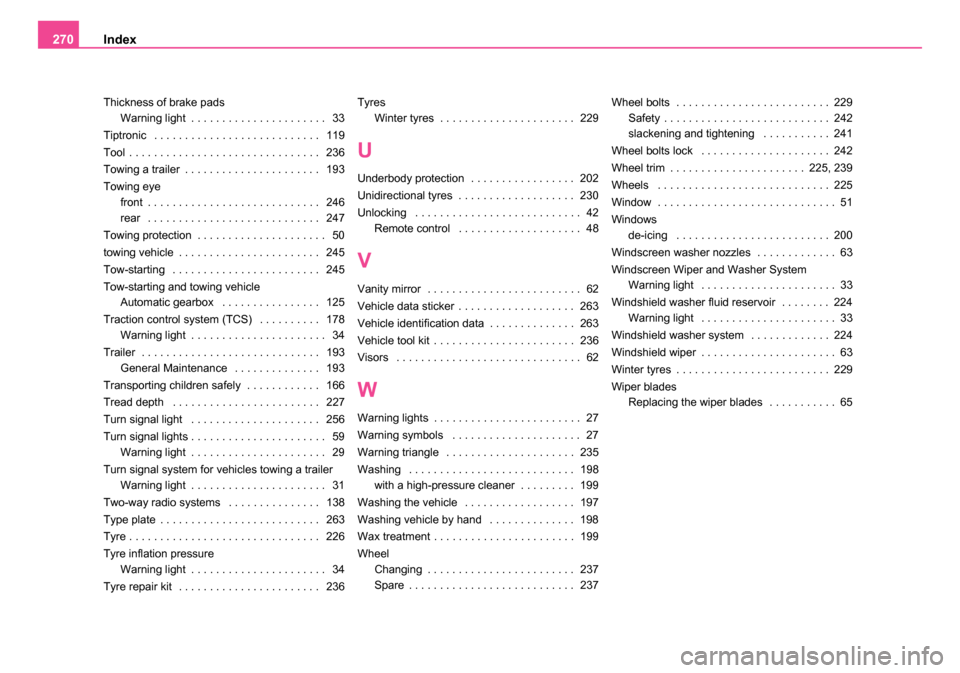
Index
270
Thickness of brake pads
Warning light . . . . . . . . . . . . . . . . . . . . . . 33
Tiptronic . . . . . . . . . . . . . . . . . . . . . . . . . . . 119
Tool . . . . . . . . . . . . . . . . . . . . . . . . . . . . . . . 236
Towing a trailer . . . . . . . . . . . . . . . . . . . . . . 193
Towing eye front . . . . . . . . . . . . . . . . . . . . . . . . . . . . 246
rear . . . . . . . . . . . . . . . . . . . . . . . . . . . . 247
Towing protection . . . . . . . . . . . . . . . . . . . . . 50
towing vehicle . . . . . . . . . . . . . . . . . . . . . . . 245
Tow-starting . . . . . . . . . . . . . . . . . . . . . . . . 245
Tow-starting and towing vehicle Automatic gearbox . . . . . . . . . . . . . . . . 125
Traction control system (TCS) . . . . . . . . . . 178 Warning light . . . . . . . . . . . . . . . . . . . . . . 34
Trailer . . . . . . . . . . . . . . . . . . . . . . . . . . . . . 193 General Maintenance . . . . . . . . . . . . . . 193
Transporting children safely . . . . . . . . . . . . 166
Tread depth . . . . . . . . . . . . . . . . . . . . . . . . 227
Turn signal light . . . . . . . . . . . . . . . . . . . . . 256
Turn signal lights . . . . . . . . . . . . . . . . . . . . . . 59 Warning light . . . . . . . . . . . . . . . . . . . . . . 29
Turn signal system for vehicles towing a trailer Warning light . . . . . . . . . . . . . . . . . . . . . . 31
Two-way radio systems . . . . . . . . . . . . . . . 138
Type plate . . . . . . . . . . . . . . . . . . . . . . . . . . 263
Tyre . . . . . . . . . . . . . . . . . . . . . . . . . . . . . . . 226
Tyre inflation pressure Warning light . . . . . . . . . . . . . . . . . . . . . . 34
Tyre repair kit . . . . . . . . . . . . . . . . . . . . . . . 236 Tyres
Winter tyres . . . . . . . . . . . . . . . . . . . . . . 229
U
Underbody protection . . . . . . . . . . . . . . . . . 202
Unidirectional tyres . . . . . . . . . . . . . . . . . . . 230
Unlocking . . . . . . . . . . . . . . . . . . . . . . . . . . . 42Remote control . . . . . . . . . . . . . . . . . . . . 48
V
Vanity mirror . . . . . . . . . . . . . . . . . . . . . . . . . 62
Vehicle data sticker . . . . . . . . . . . . . . . . . . . 263
Vehicle identification data . . . . . . . . . . . . . . 263
Vehicle tool kit . . . . . . . . . . . . . . . . . . . . . . . 236
Visors . . . . . . . . . . . . . . . . . . . . . . . . . . . . . . 62
W
Warning lights . . . . . . . . . . . . . . . . . . . . . . . . 27
Warning symbols . . . . . . . . . . . . . . . . . . . . . 27
Warning triangle . . . . . . . . . . . . . . . . . . . . . 235
Washing . . . . . . . . . . . . . . . . . . . . . . . . . . . 198with a high-pressure cleaner . . . . . . . . . 199
Washing the vehicle . . . . . . . . . . . . . . . . . . 197
Washing vehicle by hand . . . . . . . . . . . . . . 198
Wax treatment . . . . . . . . . . . . . . . . . . . . . . . 199
Wheel Changing . . . . . . . . . . . . . . . . . . . . . . . . 237
Spare . . . . . . . . . . . . . . . . . . . . . . . . . . . 237 Wheel bolts . . . . . . . . . . . . . . . . . . . . . . . . . 229
Safety . . . . . . . . . . . . . . . . . . . . . . . . . . . 242
slackening and tightening . . . . . . . . . . . 241
Wheel bolts lock . . . . . . . . . . . . . . . . . . . . . 242
Wheel trim . . . . . . . . . . . . . . . . . . . . . . 225, 239
Wheels . . . . . . . . . . . . . . . . . . . . . . . . . . . . 225
Window . . . . . . . . . . . . . . . . . . . . . . . . . . . . . 51
Windows de-icing . . . . . . . . . . . . . . . . . . . . . . . . . 200
Windscreen washer nozzles . . . . . . . . . . . . . 63
Windscreen Wiper and Washer System Warning light . . . . . . . . . . . . . . . . . . . . . . 33
Windshield washer fluid reservoir . . . . . . . . 224 Warning light . . . . . . . . . . . . . . . . . . . . . . 33
Windshield washer system . . . . . . . . . . . . . 224
Windshield wiper . . . . . . . . . . . . . . . . . . . . . . 63
Winter tyres . . . . . . . . . . . . . . . . . . . . . . . . . 229
Wiper blades Replacing the wiper blades . . . . . . . . . . . 65
NKO 20 A05.book Page 270 Wednesday, June 21, 2006 1:42 PM